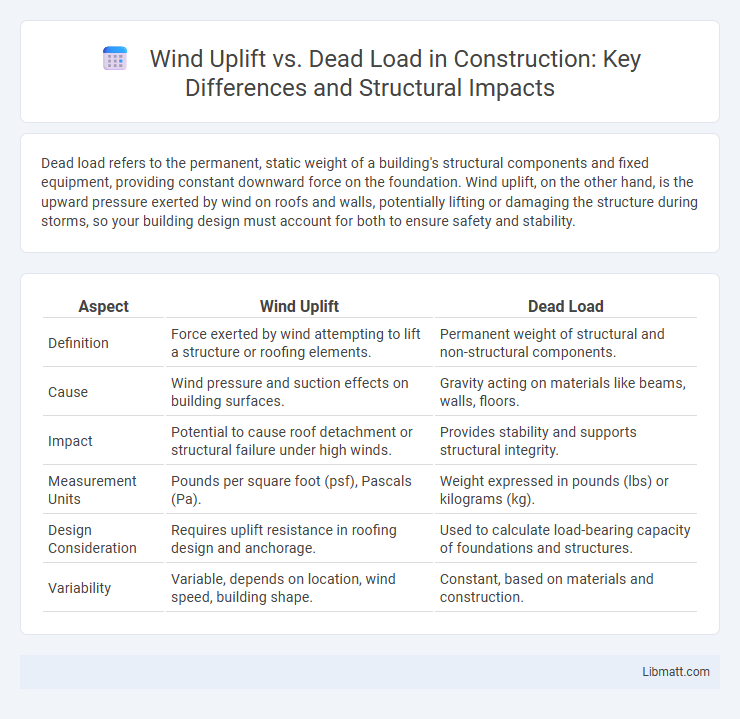Dead load refers to the permanent, static weight of a building's structural components and fixed equipment, providing constant downward force on the foundation. Wind uplift, on the other hand, is the upward pressure exerted by wind on roofs and walls, potentially lifting or damaging the structure during storms, so your building design must account for both to ensure safety and stability.
Table of Comparison
| Aspect | Wind Uplift | Dead Load |
|---|---|---|
| Definition | Force exerted by wind attempting to lift a structure or roofing elements. | Permanent weight of structural and non-structural components. |
| Cause | Wind pressure and suction effects on building surfaces. | Gravity acting on materials like beams, walls, floors. |
| Impact | Potential to cause roof detachment or structural failure under high winds. | Provides stability and supports structural integrity. |
| Measurement Units | Pounds per square foot (psf), Pascals (Pa). | Weight expressed in pounds (lbs) or kilograms (kg). |
| Design Consideration | Requires uplift resistance in roofing design and anchorage. | Used to calculate load-bearing capacity of foundations and structures. |
| Variability | Variable, depends on location, wind speed, building shape. | Constant, based on materials and construction. |
Understanding Wind Uplift: Definition and Mechanics
Wind uplift refers to the upward force exerted on a structure's roof caused by wind pressure differences between the underside and topside surfaces. This aerodynamic lifting force can exceed the roof's dead load, which is the static weight of roofing materials and structural components, challenging the structural integrity. Accurate assessment of wind uplift involves analyzing wind speed, building geometry, and exposure to ensure proper design against potential roof failure.
What is Dead Load? Basics and Significance
Dead load refers to the permanent, static weight of a structure's components, including walls, floors, roofs, and fixed equipment. Understanding dead load is crucial for structural engineers to ensure buildings can safely support their own weight without excessive stress or deformation. Your construction project's stability depends on correctly calculating dead loads to complement other forces like wind uplift.
Key Differences Between Wind Uplift and Dead Load
Wind uplift refers to the upward force exerted on a structure by wind pressure, often causing potential lifting or detachment, while dead load represents the constant, downward force from the weight of the structure and its fixed components. Wind uplift is a dynamic load that varies with wind speed and direction, whereas dead load remains static and predictable throughout the building's lifespan. Understanding these key differences ensures your design accommodates both forces for structural stability and safety.
Impact of Wind Uplift on Roof Systems
Wind uplift forces exert a significant impact on roof systems by creating an upward pressure that can compromise structural integrity and lead to roof membrane detachment or damage. This dynamic force often exceeds the static weight of dead loads, such as roofing materials and structural components, making it critical to design roofs with adequate anchorage and resistance to uplift pressures. Understanding wind uplift behavior is essential for engineers and architects to ensure long-term durability and safety of roofing assemblies in high-wind regions.
The Role of Dead Load in Structural Stability
Dead load provides the essential baseline weight that stabilizes a structure against wind uplift forces by anchoring it firmly to the foundation. The combination of dead load and wind uplift pressure determines the structural design criteria to prevent overturning or displacement during high wind events. Your building's stability relies heavily on accurately calculating dead load to counteract the dynamic effects of wind uplift for safety and durability.
Building Codes: Wind Uplift vs Dead Load Requirements
Building codes specify distinct requirements for wind uplift and dead load to ensure structural safety and stability. Wind uplift mandates account for forces exerted by wind pressure lifting roofing components, requiring materials and fasteners designed to resist these upward forces. Dead load requirements focus on the permanent weight of structural elements, ensuring your building can support its own weight without excessive deflection or failure.
Material Selection for Wind Uplift and Dead Load Resistance
Material selection critically impacts a structure's ability to resist wind uplift and dead loads, with high-strength steel and reinforced concrete providing exceptional durability and load-bearing capacity. Engineered composites and treated timber offer lightweight solutions that enhance wind uplift resistance while maintaining structural integrity under dead loads. Optimizing your material choice ensures balanced performance against both dynamic uplift forces and constant gravitational stress.
Common Failures Related to Wind Uplift and Dead Load
Common failures related to wind uplift include membrane detachment, fastener pull-out, and edge separation due to insufficient fastening or inadequate adhesion in roofing systems. Dead load failures often arise from structural deflection, compression of insulation materials, or substrate deformation that compromises roof integrity. Proper engineering design must account for both dynamic wind uplift pressures and static dead loads to prevent premature roof system deterioration and maintain safety.
Design Strategies to Balance Wind Uplift and Dead Load
Design strategies to balance wind uplift and dead load focus on optimizing structural components to resist upward wind forces while supporting gravitational weight effectively. Engineers use reinforced connections, increased dead load through heavier materials, and anchoring systems to enhance stability and prevent roof detachment under high wind conditions. Your building's safety depends on accurately calculating these forces and implementing tailored solutions that maintain structural integrity against both uplift pressure and vertical loads.
Case Studies: Real-World Examples of Wind Uplift and Dead Load Effects
Case studies from coastal regions illustrate that wind uplift forces can exceed 150 pounds per square foot, causing roofing materials to detach if dead loads are insufficiently designed to counteract these pressures. In hurricane-prone areas like Florida, buildings with heavier dead loads such as concrete slabs demonstrated significantly better resistance to wind uplift compared to structures relying solely on lightweight materials. These real-world examples emphasize the critical balance between dead load stabilization and wind uplift mitigation for structural integrity in extreme weather conditions.
Wind uplift vs Dead load Infographic

 libmatt.com
libmatt.com